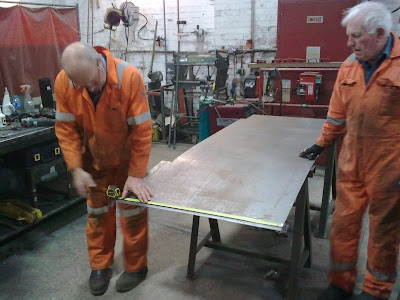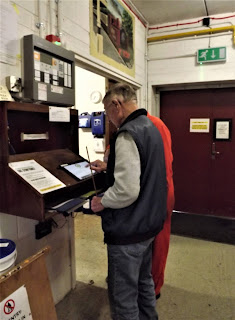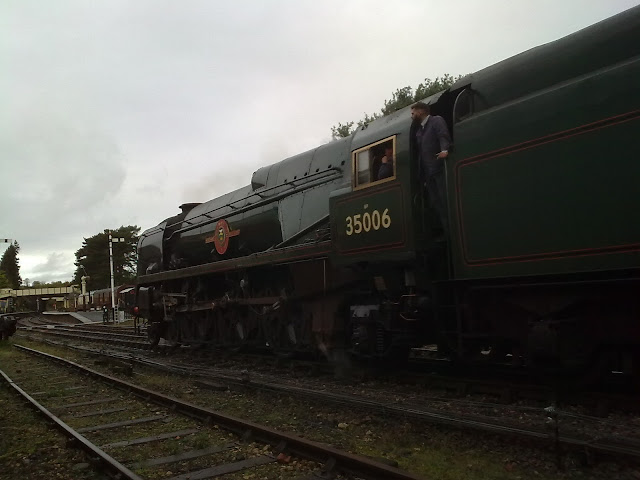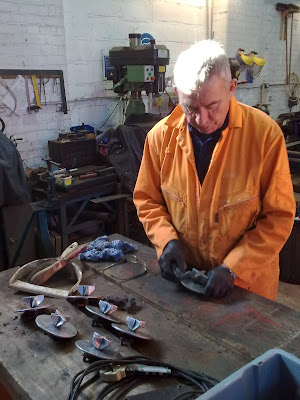Thursday 29th - Engineering the flavour of the day
In sharp contrast to Tuesday, a very busy day at C&W with some of our engineers coming in today instead of Wednesday to help progress the work to refit the missing doors on RMB 1808. With so many things going on throughout the day and busy with my own tasks, I didn't capture everything, so apologies to anyone I missed out.
Whoa! What's happened here on the completed Cotswold side of RMB 1808?The missing door is now on one of the Door Team's benches. The lock needed changing, which in this case also meant that a different handle needed to go on. In the circumstances this is a lot easier to accomplish with the door off the coach.
Trevor is working on the fitting of the handle. Old towels were used to protect the main paintwork when the door had to be turned over.
Some paint repairs will be inevitable because the replacement handle has a smaller base plate - thankfully the cream is easier to put right.
Also on the Cotswold side of 1808, Richard Budd ("Richard II") is fitting the planned new battery charger.In the Malvern side central doorway Bryan is removing the strenghtening metal bars that has been welded in the hinge locations to the backs of new panelling.The new brackets to be welded on instead were being manufactured by Rex and Nick.
A zoomed photo of Rex cutting the small triangular sections.
The completed brackets.Nick then welded three of the brackets where the original metal reinforcements had been for the centre doorway. This is the bottom one, now coated in red oxide.Rex later moved to the Malvern-side south doorway of 1808 to do the same as Bryan above.
Nick marking out on the large piece of sheet metal. At the time I took the photo without asking what this was for.
However, later on I captured Ken (Reeves) using the anvil to hammer curved ends to a narrow length of sheet metal, so mystery solved.
Ken is in fact making up the relevant metal parts for the corridor connection rain covers. These are now dangling on the Paintshop hooks and coated in red oxide.
Nick tidying up the metalworking area after all that cutting and angle grinding.
Ken (Austin) making more brackets for toilet down pipes.
Moving on to CK 16221 and the refurbishment of the second bogie. Tony is re-attaching the parts of the brake mechanism that were recently cleaned.
Well, that's one lot sorted, and now here's some more to be cleaned.
Axlebox oil pads, cleaned up and drying off in the empty containers of the degreasing fluid. What an excellent and novel way to store them!
At the far end of the Barn Gerry is cleaning up another of the underseat grills from 16221.
After attending an All Departments H & S meeting lasting much of the day, Ainsley spent the last hour or so of the day filling and sanding on the Malvern side of 16221. What better way to wind down than a bit of physical work!
A new battery box for 16221. I sanded down the edges all round as ply can be a bit splintery. It is now ready for priming, undercoat Dark Grey and finally Underframe Black top coat.Phil was working on the pipework for the toilet compartment of BSK 34929.SO 4787 was in the Barn for an underframe check up, so a golden opportunity for Bob to remove some flaking bitumen and paint from the roof sides. With bare metal showing, a coat of black etch primer where needed will be followed by some High Roof Build paint that we have left.
Apparently this had been placed on top of the First Aid box in the Paintshop the day before. Paul has just gone on holiday but will no doubt be checking the blog on his phone. Have a good holiday Paul!






































































